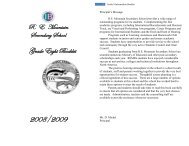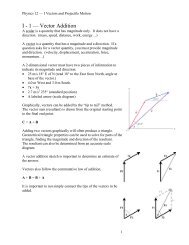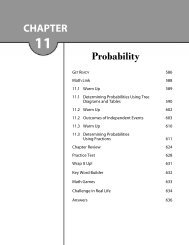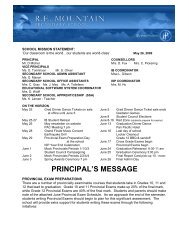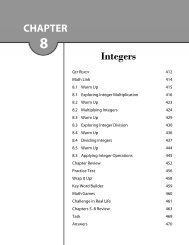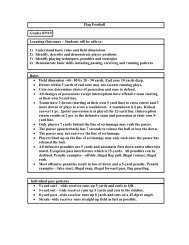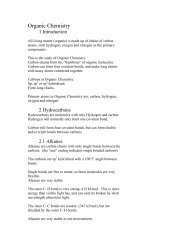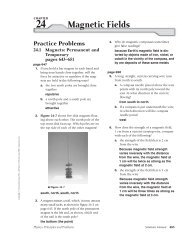Ch 12 Answers
Ch 12 Answers
Ch 12 Answers
Create successful ePaper yourself
Turn your PDF publications into a flip-book with our unique Google optimized e-Paper software.
<strong>Ch</strong>apter <strong>12</strong> continued<br />
46. Which liquid would an ice cube cool faster,<br />
water or methanol? Explain.<br />
Methanol, because it has a lower<br />
specific heat; for a given mass and heat<br />
transfer, it generates a bigger T since<br />
Q mCT.<br />
47. Equal masses of aluminum and lead are<br />
heated to the same temperature. The pieces<br />
of metal are placed on a block of ice. Which<br />
metal melts more ice? Explain.<br />
The specific heat of aluminum is much<br />
greater than that of lead; therefore, it<br />
melts more ice.<br />
48. Why do easily vaporized liquids, such as<br />
acetone and methanol, feel cool to the skin?<br />
As they evaporate, they absorb their<br />
heat of vaporization from the skin.<br />
49. Explain why fruit growers spray their trees<br />
with water when frost is expected to protect<br />
the fruit from freezing.<br />
The water on the leaves will not freeze<br />
until it can release its heat of fusion.<br />
This process keeps the leaves warmer<br />
longer. The heat capacity of the ice<br />
slows down the cooling below 0°C.<br />
50. Two blocks of lead have the same temperature.<br />
Block A has twice the mass of block B.<br />
They are dropped into identical cups of<br />
water of equal temperatures. Will the two<br />
cups of water have equal temperatures after<br />
equilibrium is achieved? Explain.<br />
The cup with block A will be hotter<br />
because block A contains more thermal<br />
energy.<br />
51. Windows Often, architects design most of<br />
the windows of a house on the north side.<br />
How does putting windows on the south side<br />
affect the heating and cooling of the house?<br />
In the northern hemisphere, the sunlight<br />
comes from the south. The Sun’s<br />
light would help heat the house in the<br />
winter but also would also heat the<br />
house in the summer.<br />
Mastering Problems<br />
<strong>12</strong>.1 Temperature and Thermal Energy<br />
pages 336–337<br />
Level 1<br />
52. How much heat is needed to raise the<br />
temperature of 50.0 g of water from<br />
4.5°C to 83.0°C?<br />
Q mCT<br />
(0.0500 kg)(4180 J/kg°C)<br />
(83.0°C 4.5°C)<br />
1.6410 4 J<br />
53. A 5.0010 2 -g block of metal absorbs 5016 J<br />
of heat when its temperature changes from<br />
20.0°C to 30.0°C. Calculate the specific<br />
heat of the metal.<br />
Q mCT<br />
Q<br />
so C <br />
mT<br />
<br />
<br />
1.0010 3 J/kg°C<br />
1.0010 3 J/kgK<br />
54. Coffee Cup A 4.0010 2 -g glass coffee cup<br />
is 20.0°C at room temperature. It is then<br />
plunged into hot dishwater at a temperature<br />
of 80.0°C, as shown in Figure <strong>12</strong>-18.<br />
If the temperature of the cup reaches that of<br />
the dishwater, how much heat does the cup<br />
absorb? Assume that the mass of the dishwater<br />
is large enough so that its temperature<br />
does not change appreciably.<br />
4.0010 2 g<br />
Q mCT<br />
5016 J<br />
<br />
(5.0010 1 kg)(30.0°C 20.0°C)<br />
20.0°C 80.0°C<br />
(4.0010 1 kg)(840 J/kg°C)<br />
(80.0°C 20.0°C)<br />
2.0210 4 J<br />
■ Figure <strong>12</strong>-18<br />
278 Solutions Manual Physics: Principles and Problems<br />
Copyright © Glencoe/McGraw-Hill, a division of The McGraw-Hill Companies, Inc.





